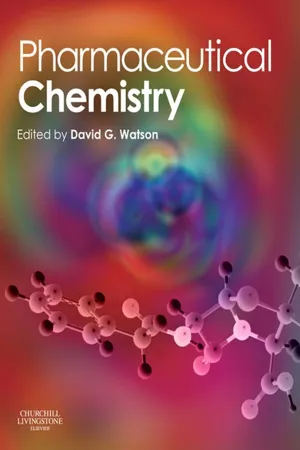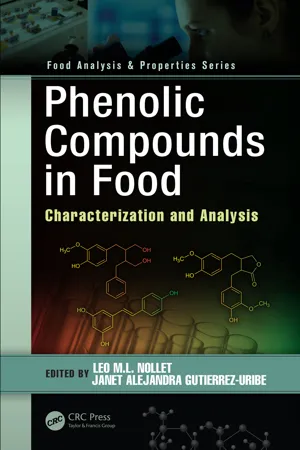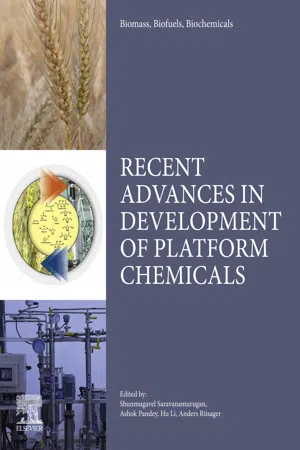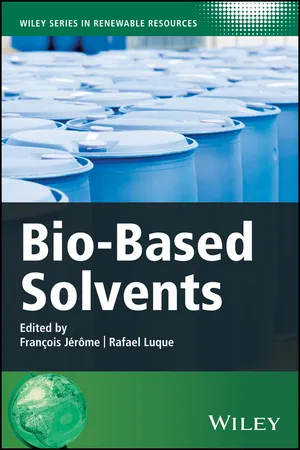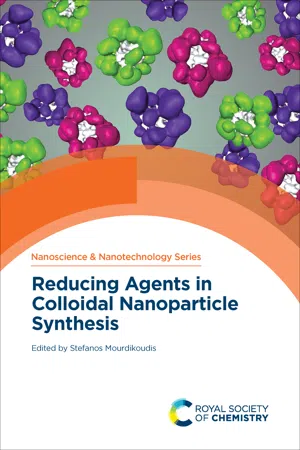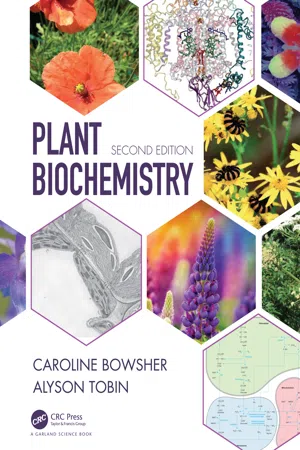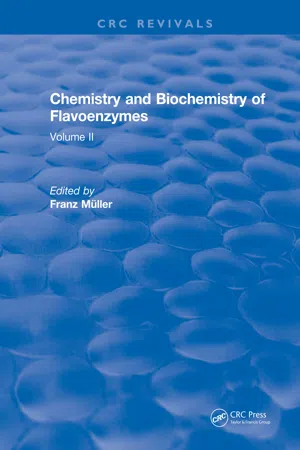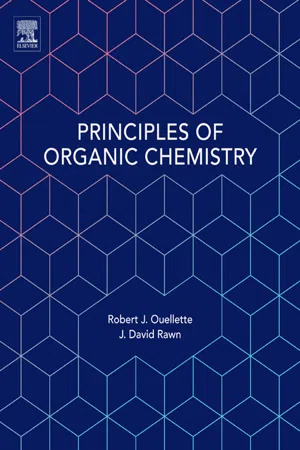Chemistry
Phenol
Phenol is a chemical compound consisting of a hydroxyl group (-OH) bonded directly to a benzene ring. It is a white crystalline solid with a distinct odor and is commonly used in the production of various chemicals, including plastics, pharmaceuticals, and disinfectants. Phenol is also used as an antiseptic and anesthetic in medicine.
Written by Perlego with AI-assistance
Related key terms
Related key terms
1 of 4
Related key terms
1 of 3
8 Key excerpts on "Phenol"
- eBook - ePub
- David G. Watson(Author)
- 2011(Publication Date)
- Churchill Livingstone(Publisher)
Ka value 10.0 and is soluble 1 in 20 in water. It is still used occasionally in the form of an oily injection, because of its caustic nature, to promote sclerosis in the treatment of haemorrhoids.Figure 5.10 Phenols.When additional hydroxyl groups are attached to the benzene ring a range of fairly reactive compounds, e.g. catechol, hydroquinone and pyrogallol (Fig. 5.10 ) results. These compounds, unlike ordinary alcohols, are all readily oxidised and the oxidation products (quinones) are also highly reactive with biological structures and certainly not desirable as the products of drug metabolism. The Phenolic hydroxyl group is widely found in natural products such as tyramine, dopamine which is used therapeutically, and in Phenolic pigments such as quercetin which is a dietary antioxidant compound (Fig. 5.10 ). Phenolic acids occur widely in the diet; for example, the rich content of Phenolic acids in cranberry juice is the basis for its mild antibacterial action in treating cystitis. Phenolic groups can have a strong effect on biological activity. The presence of a catechol group is critical for biological activity in noradrenaline; p -octopamine lacks the m -hydroxyl group found in noradrenaline (Fig 5.11 ) and has little activity at noradrenergic receptors. However, by a quirk of nature it fulfils the role of noradrenaline in the nervous systems of insects.Figure 5.11 Biologically active Phenols.Phenol acidity and antibacterial action
Unlike alcohols, which are neutral, Phenols are weakly acidic. The acidity of the hydroxyl group results from the electron withdrawing effect of the aromatic ring which weakens the OH bond. The acidic strength of the Phenol increases with the strength of electron withdrawal. Thus electron withdrawing substituents such as nitro or chloro groups increase the acidity of the Phenol (Fig. 5.12 ). The effects of such substituents are greatest in the ortho and para positions. The amphiphilic nature of Phenols means that they are surface active and can absorb on membrane surfaces such as bacterial membranes. The more acidic Phenols have stronger antibacterial action and chloroxylenol is commonly used in disinfectants, ethylparaben is used as a preservative in liquid formulations and triclosan (Fig. 5.12 - eBook - ePub
Phenolic Compounds in Food
Characterization and Analysis
- Leo M.L. Nollet, Janet Alejandra Gutierrez-Uribe(Authors)
- 2018(Publication Date)
- CRC Press(Publisher)
As hydroxyl groups holders, Phenolics have the capacity to form hydrogen bonds and at the same time show slight acidity, forming the corresponding negative and nucleophilic phenoxide ions. The implication of this ionization property enhances its solubility in water and its chemical stability. Additionally, the presence of aromatic rings assists the delocalization of electrons or moving the negative charge along the ring system. The phenoxy ions may further release another electron to form the corresponding radical, which may undergo oxidative coupling reactions. These properties allow the biosynthesis of Phenolic compounds and the interactions among plants and their environments. Most Phenolic compounds have their origin in the shikimic acid pathways and from the acetyl coenzyme A and its activated form (Waterman and Mole 1994).2.2 Milestones in PolyPhenol History and ResearchPhenol was discovered in 1834 by Friedlieb Ferdinand Runge, who extracted it in an impure form from coal tars. Later, in 1836, Auguste Laurent used the name phène for benzene; from there, the terms Phenol and phenyl emerged. In 1843, French chemist Charles Gerhardt created the name Phenol , referring to this compound. However, it wasn’t until 1894 that the first known use of the word polyPhenol appeared, according to the International Scientific Vocabulary.Sir Joseph Lister (1827–1912) reported his pioneering surgery techniques and use of the antiseptic properties of Phenol in surgery in 1867.In the early 1900s, Folin and colleagues carried out intensive work on protein determinations (Folin and Ciocalteu 1927). The major publication dealt with variants of the Folin–Denis reagent applied to the determination of tyrosine and tryptophane in proteins. Eventually this would be known widely as the Folin–Ciocalteu Phenol reagent.Lowry et al. (1951) proclaimed that using the Folin–Ciocalteu Phenol reagent for the measurement of proteins, that is, for the reaction with copper in alkali conditions and then reading the change in color was simpler and more sensitive than other methods. The Lowry paper became the most cited publication ever. Although more precise methods have been introduced since then, it still holds a rank in Thomson Reuters Web of Science, with more than 300,000 citations (Van Noorden et al. 2014). - eBook - ePub
Biomass, Biofuels, Biochemicals
Recent Advances in Development of Platform Chemicals
- S. Saravanamurugan, Hu Li, Anders Riisager, Ashok Pandey(Authors)
- 2019(Publication Date)
- Elsevier(Publisher)
It also serves as a precursor to a large array of drugs, herbicides, cosmetics (including sunscreens, hair coloring, and skin lightning preparations), and pharmaceuticals [ 6, 7 ]. Aromatic Phenols are naturally reactive compounds; they are acidic in nature owing to the presence of an OH group. When reacting with metals, they form chelate complexes and are easily oxidized and form polymers. According to a 2006 survey, the global production of Phenols was 80 million tons, but more than 95% was produced from fossil-derived benzene by the cumene process [8]. During lignin degradation, catalytic reduction reactions aim to remove the extensive functionality of lignin subunits to generate simpler monomeric compounds, including Phenols, benzene, toluene, and cyclohexane, which can be further hydrogenated to alkanes (carbon atoms C7–18) via coupling reactions or used as platform chemicals in an appropriate reaction environment [ 9, 10 ], as displayed in Fig. 18.1. To a larger extent, cyclohexanol, cyclohexanone, and cyclohexane are considered to be valuable products in the application of direct blending with petroleum fuels [11]. Conventionally, lignin valorization is conducted through thermal hydrogenolysis (depolymerization), which could be a base-catalyzed, acid-catalyzed, metallic-catalyzed, and ionic liquid–assisted depolymerization for the synthesis of various Phenolics [ 6, 12, 13 ]. Although lignin forms a large proportion of the nonfood biomass, which is categorized as eligible for the production of renewable and carbon-neutral liquid fuels and chemical compounds, its separation from covalently linked materials such as cellulose and hemicellulose is a major technical hurdle that needs to be overcome for cost-effective production [14]. Compared with many bulk aromatic chemicals used in the chemical industry, the aromatic units that make up lignin are highly functionalized (i.e., oxygenated and alkylated) [15] - eBook - ePub
- François Jérôme, Rafael Luque, François Jérôme, Rafael Luque(Authors)
- 2017(Publication Date)
- Wiley(Publisher)
Figure 7.1 ) [16, 17]. Particularly, the short-chain alkylPhenols can be manufactured directly from lignin by using recently developed technologies [16, 17]. The long-chain alkylPhenols can also be produced from biomass in a few steps. However, thus far, limited studies have focused on using alkylPhenols as bio-based solvents. Hence, this chapter will discuss the main properties of alkylPhenols, their production and their utilization as solvents. Finally, the stability and toxicity aspects of alkylPhenols are highlighted and an outlook is provided.7.2 Properties of AlkylPhenols
AlkylPhenols are a family of Phenol-derived organic compounds obtained by replacing one or more of the ring hydrogens with alkyl groups [18, 19]. In this chapter, we mainly discuss the mono-alkylated Phenols. Pure alkylPhenols appear colourless or white to a pale yellow, and have a Phenol-type odour. They show the same sensitivity to oxygen as Phenol, in the sense that oxidation can cause discoloration. The properties of alkylPhenols are strongly affected by the size and the configuration of the alkyl group. The physical form of alkylPhenols at 25°C is determined by the type of alkyl group and the mutual positions of the alkyl and hydroxyl groups. For example, ortho-cresol and Phenol are solids, whereas meta-cresol is a liquid. The boiling points of alkylPhenols increase continuously with increasing size of the alkyl group, hence molecular weight (MW) (Figure 7.2 ). The para-alkylPhenols have higher boiling points than the corresponding ortho-isomers. However, the difference in boiling points between the meta- and para-isomers is very small, which leads to difficulties in separating them by distillation. The n-alkylPhenols have higher boiling points than the corresponding iso-alkylPhenols. The solubility of alkylPhenols in water decreases logarithmically with increasing size of the alkyl group (Figure 7.2 - Stefanos Mourdikoudis, Stefanos Mourdikoudis(Authors)
- 2021(Publication Date)
- Royal Society of Chemistry(Publisher)
11 The acidic character as well as the chemical and physical properties of Phenol derivatives may differ as a function of the number of hydroxyl and additional functional groups.It is important to understand the properties of the Phenol derivative chosen for the synthesis in order to optimize the reaction conditions and achieve uniform and well-distributed MNPs with controlled size, shape, and morphology. In general, as the number of –OH groups increases, both the boiling and the melting points increase, as well as the water solubility, due to the strong intermolecular forces (e.g. hydrogen bonding). A few exceptions to this rule are observed: Phenol, with one hydroxyl group, hydroquinone, with two, and phloroglucinol, with three, have water solubilities of 83 g L−1 , 72 g L−1 , and 10 g L−1 , respectively. This decrease in solubility is a result of the formation of symmetrical and rigid molecule networks via hydrogen bonds in these molecular structures, which prevent the penetration of the solvent used in the reaction.12 ,13In addition, if the ring has other substituents such as carboxyl (–COOH), nitro (–NO2 ), and amino (–NH2 ) groups, their close proximity to the hydroxyl group will further enable the hydrogen bonding in the molecule, lessening the solvation of the Phenol derivative and thus making it less water soluble in the reaction medium (e.g. ortho substitution compared to para substitution).14The pK a value is the negative log of the acid dissociation constant and thus an indication of the acid strength of the molecule. Introduction of more –OH groups or other electron-donating substituents such as amino (–NH2 ), alkyl (–R), or alkoxy (–OR) groups will alter the charge density on the aromatic ring in such a way that its pK a value will increase as a result. Therefore, Phenols with such substituents are less acidic compared to unsubstituted Phenols or to those with electron-withdrawing ones such as halides, –NO2 , and –COOH groups. It is also important to note that as the number of chlorine atoms attached to the aromatic ring increases, the acidity of the molecule increases with the decreasing pK a- eBook - ePub
- Caroline Bowsher, Alyson Tobin(Authors)
- 2021(Publication Date)
- Garland Science(Publisher)
Figure 11.2 a).Figure 11.1 Structure of Phenol. A hydroxyl, or Phenolic group, is attached to a 6-carbon phenyl ring. Phenols are acidic as the phenyl ring is tightly bound to the –O of the hydroxyl group, while the relatively loose bonding between the –O and –H allows a H+ to dissociate in solution to leave a negatively charged Phenolate ion.Figure 11.2 Examples of the major Phenolic groups that occur in plants. a. Simple phenylpropanoids; b. Coumarins and furanocoumarins; c. Benzoic acid derivatives; d. Flavonoids: Chalcones , R1 = OH R2 = OH tetrahydroxychalcone; R1 =H R2 =OH isoliquiritigenin. Flavanones , R1 = OH R2 = OH naringenin; R1 = H R2 = OH liquiritigenin; Flavan–3-ols , (-)-epicatechin has R -stereochemistry at C3 (i.e. OH group enters the plane, as shown); (+)-catechin has S -stereochemistry at C3 (i.e. OH group comes out from the plane). Flavones , R1 = H R2 = H apigenin; R1 = OH R2 = H luteolin. Isoflavones R1 = OH genistein; R1 = H daidzein. Flavonols R1 = H R2 = H kaempferol; R1 = OH R2 = OH myricetin; R1 = H R2 = OH quercetin. Anthocyanins R1 = OH R2 = H cyanidin; R1 = OH R2 = OH delphinidin; R1 = H R2 = H pelargonidin; e. Stilbenes; f. Lignin; g. Tannins (From L. Taiz and E. Zeiger, editors, Plant Physiology, 2nd edition, 2006, Figure 8.14 , 2006. Reprinted with permission from Sinauer Associates Inc.)The biological functions of plant Phenolics are many and varied, including scents and pigments, poisons and feeding deterrents, allelopathic compounds, signaling molecules, structural components, and antifungal and antimicrobial agents (Box 11.1).Box 11.1 Biological Functions of Plant PhenolicsPlant Phenolics serve a range of biological functions. They can provide visual signals, scents, and flavors that attract pollinators and deter herbivores. Some are toxic to mammals and insects, while others provide defense against fungal and bacterial pathogens. Some serve plant-specific functions, as germination inhibitors, ultraviolet-protectants, or signaling compounds. - eBook - ePub
- Franz Muller(Author)
- 2018(Publication Date)
- CRC Press(Publisher)
Eur. J. Biochem., 170, 343, 1987. With permission.)IV. Biological Significance
A. Phenol as Carbon and Energy Source
Phenolic compounds are widely distributed in nature, deriving mainly from wood lignins. Their mineralization is vital to a proper functioning of the carbon cycle. Hence, the great importance of those flavoprotein hydroxylases, which initiate the degradation of aromatic acids, which are decomposition produets of lignins. The process of lignin degradation dates back to the cambrian era, when woody plants began to appear, some 370 million years ago. The aromatic hydroxylases acting on Phenolic acids must thus have evolved about that time. Phenol and its simple methyl, amino, or halogen derivatives are toxic produets of industriai origin. It is ali the more remarkable that their degradation is initiated by Phenol hydroxylases which, albeit in many respects similar to those involved in lignin degradation, have no aromatic substrates in common.Higher organisms remove toxic aromatic substances using monooxygenases of the P-450 type. These are mere detoxification processes, in which the carbon and energy content of such substances is lost. By contrast, microbes detoxify aromatic substances using flavoprotein hydroxylases and, in most cases, they also manage to fully utilize their content of carbon and energy. The efficiency of Phenol utilization by the lower eukaryote, T. cutaneum, is remarkable. In chemostat cultures, the celi yields on Phenol are comparable to those on such easily utilized carbon sources as glucose or acetate. The “maintenance coefficient” on Phenol as a sole carbon source is extremely low, indicating very efficient energy coupling.55 In steady-state continuous cultures on Phenol without carbon limitation, there is a considerable increase in the level of several intracellular enzymes, including those related to the Krebs cycle and to generation of reducing power.55 In the presence of Phenol, the organism even develops a specific active transport system to bring this compound into the cell.56 ,57 - eBook - ePub
- Robert J. Ouellette, J. David Rawn(Authors)
- 2015(Publication Date)
- Elsevier(Publisher)
8Alcohols and Phenols
8.1 The Hydroxyl Group
Families of organic compounds that have functional groups containing oxygen include alcohols, Phenols, ethers, aldehydes, ketones, acids, esters, and amides. Alcohols and Phenols both contain a hydroxyl group (–OH). A hydroxyl group is also present in carboxylic acids, but it is bonded to a carbonyl carbon atom. As a result, the chemistry of carboxylic acids, the subject of Chapter 12 , is substantially different from the chemistry of alcohols and Phenols. Alcohols and Phenols can be viewed as organic “relatives” of water in which one hydrogen atom is replaced by an alkyl group or an aryl group. Alcohols contain a hydroxyl group bonded to an sp3 -hybridized carbon atom. Phenols have a hydroxyl group bonded to an sp2 -hybridized carbon atom of an aromatic ring.Common Names of Alcohols
The common names of alcohols consist of the name of the alkyl group (Section 3.3 ) followed by the term alcohol . For example, CH3 CH2 OH is ethyl alcohol and CH3 CH(OH)CH3 is isopropyl alcohol. Other common names are allyl alcohol and benzyl alcohol, whose structures are shown below.The IUPAC system of naming alcohols is based on the longest chain of carbon atoms that includes the hydroxyl group as the parent chain. The parent name is obtained by substituting the suffix -ol for the final -e of the corresponding alkane. The IUPAC rules are as follows:1.The position of the hydroxyl group is indicated by the number of the carbon atom to which it is attached. The chain is numbered so that the carbon atom bearing the hydroxyl group has the lower number.The longest chain that contains the hydroxyl group has 4 carbon atoms. An OH group is at C-2 and a methyl group is at C-3. So, the name is 3-methyl-2-butanol2.When the hydroxyl group is attached to a ring, the ring is numbered starting with the carbon atom bearing the hydroxyl group. Numbering continues in the direction that gives the lowest numbers to carbon atoms with substituents such as alkyl groups. The number 1 is not used in the name to indicate the position of the hydroxyl group.
Index pages curate the most relevant extracts from our library of academic textbooks. They’ve been created using an in-house natural language model (NLM), each adding context and meaning to key research topics.
Explore more topic indexes
Explore more topic indexes
1 of 6
Explore more topic indexes
1 of 4
